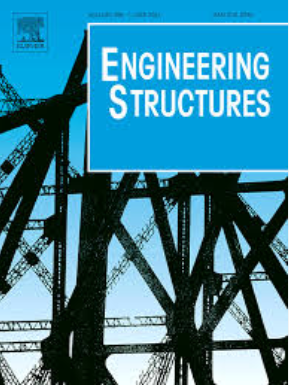创新的木材连接系统,结合室内粘合剂应用和现场无粘合剂组装
IF 6.4
1区 工程技术
Q1 ENGINEERING, CIVIL
引用次数: 0
摘要
在木材连接中,与通常采用的机械连接相比,粘接连接通常更便宜、更坚固、更坚固。然而,粘接线质量对各种工艺参数很敏感;因此,通常最好在工厂进行粘合,在组装期间控制这些参数,然后将整个结构运输到施工现场。由于运输能力有限,这导致木结构的尺寸受到限制。对于完全胶合的木材连接,另一个值得关注的问题是,在最终破坏之前,它们的非延性行为是至关重要的,特别是在地震区域。本文的重点是设计两种创新的连接系统,旨在克服这两个关键的限制。这两种系统都具有室内粘合剂应用和现场无粘合剂组装的优点。第一个连接系统采用混合解决方案,通过钢棒和桦木胶合板的特殊“车轮齿轮”缺口连接预制构件,而第二个连接系统在现场组装时采用纯胶合板缺口连接。这两种新型连接系统在抗力矩和抗力应用中都有潜在的应用前景。在本研究中,它们以框架角的形式进行了介绍和设计,其中存在弯矩,轴力和剪力。建立了预测各种可能失效模式下承载力的分析模型,并通过试验结果进行了验证。结果表明,第一连接体系具有中等的延性,其承载能力令人满意。如果使用较厚的胶合板,则可以进一步提高其能力,使其与完全胶合连接一样牢固。第二连接系统具有较低的强度和刚度。然而,它仍然可以应用于非关键连接区域,在那里没有大量的外部负载存在。本文章由计算机程序翻译,如有差异,请以英文原文为准。
Innovative timber connection systems with the combination of indoor adhesive application and on-site adhesive-free assembly
In timber connections, adhesively bonded connections are, in general, cheaper, stiffer, and stronger compared to typically adopted mechanical connections. However, bond line quality is sensitive to various process-related parameters; thus, it is generally preferable to do the gluing in the factory with these parameters controlled during assembly and then transport the entire structure to the construction site. This leads to a limitation on the size of the timber structure owing to the limited transportation capacities. Another concern regarding fully glued timber-to-timber connections falls in their non-ductile behavior prior to the ultimate failure, which is crucial, especially in seismic regions. This paper focuses on the design of two innovative connection systems aimed at overcoming these two key limitations. Both systems offer the advantages of indoor adhesive application and on-site adhesive-free assembly. The first connection system involves a hybrid solution connecting prefabricated elements by means of steel rods and special ‘‘wheel-geared’’ notches of birch plywood, while the second connection system employs pure plywood notched connections during the on-site assembly. These two novel connection systems have potential for use in both moment- and force-resisting applications. In this study, they were introduced and designed in the format of a frame corner, where bending moment, axial force, and shear force are present. Analytical models predicting the capacity for each possible failure mode were developed and then validated by the test results. It can be found that the first connection system exhibits moderate ductile behavior, and its load-bearing capacity is considered to be satisfactory. The capacity can be further improved to be as strong as the fully glued connection if thicker plywood plates are utilized. The second connection system possesses lower strength and stiffness. However, it could still be applied in non-critical connection regions where no substantial external load exists.
求助全文
通过发布文献求助,成功后即可免费获取论文全文。
去求助
来源期刊

Engineering Structures
工程技术-工程:土木
CiteScore
10.20
自引率
14.50%
发文量
1385
审稿时长
67 days
期刊介绍:
Engineering Structures provides a forum for a broad blend of scientific and technical papers to reflect the evolving needs of the structural engineering and structural mechanics communities. Particularly welcome are contributions dealing with applications of structural engineering and mechanics principles in all areas of technology. The journal aspires to a broad and integrated coverage of the effects of dynamic loadings and of the modelling techniques whereby the structural response to these loadings may be computed.
The scope of Engineering Structures encompasses, but is not restricted to, the following areas: infrastructure engineering; earthquake engineering; structure-fluid-soil interaction; wind engineering; fire engineering; blast engineering; structural reliability/stability; life assessment/integrity; structural health monitoring; multi-hazard engineering; structural dynamics; optimization; expert systems; experimental modelling; performance-based design; multiscale analysis; value engineering.
Topics of interest include: tall buildings; innovative structures; environmentally responsive structures; bridges; stadiums; commercial and public buildings; transmission towers; television and telecommunication masts; foldable structures; cooling towers; plates and shells; suspension structures; protective structures; smart structures; nuclear reactors; dams; pressure vessels; pipelines; tunnels.
Engineering Structures also publishes review articles, short communications and discussions, book reviews, and a diary on international events related to any aspect of structural engineering.
 求助内容:
求助内容: 应助结果提醒方式:
应助结果提醒方式:


